
Janine Antoni in collaboration with Anna Halprin, Paper Dance, 2019 (2013). Performance view, The Contemporary Austin – Jones Center. Courtesy the artist and Luhring Augustine, New York. Image courtesy The Contemporary Austin. Photograph © Giulio Sciorio.
I first encountered Janine Antoni’s work in grad school in the late ’90s. I was taken with her use of non-traditional materials (specifically chocolate and lard) and her use of the body and body parts as tools of communication (hair, teeth, tongue and eyelashes). But I was also greatly inspired by her unapologetic nod to first-wave feminist artists and her subversion of art-historical white, male hegemony.
For 30 years, Antoni has continued her sculptural investigations of the body while manifesting new and imaginative expansions on her themes and ideas. In recent years, Antoni has incorporated dance and somatic movement into her work — first as a strategy to unlock creativity, and later as it has evolved into collaborations and performances with other artists.
This conversation has unfolded concurrently with Antoni’s exhibition at The Contemporary Austin titled Janine Antoni and Anna Halprin: Paper Dance. The Contemporary describes it as “…a dynamic retrospective spanning thirty years of photographs and sculptures by Janine Antoni and a solo dance performance by the artist developed collaboratively with pioneering dancer and choreographer Anna Halprin.” It runs through March 17.
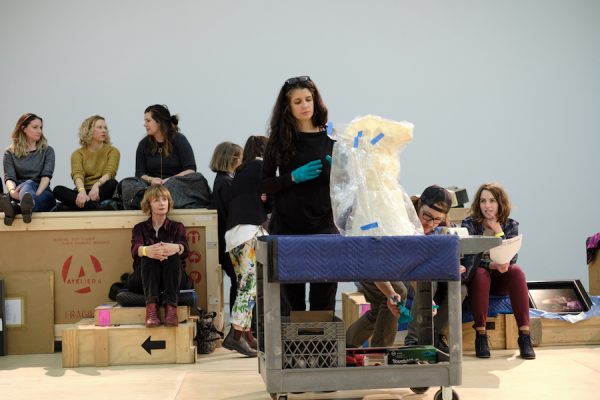
Janine Antoni in collaboration with Anna Halprin, Paper Dance, 2019 (2013). Performance view, The Contemporary Austin – Jones Center. Courtesy the artist and Luhring Augustine, New York. Image courtesy The Contemporary Austin. Photograph © Giulio Sciorio.
Colette Copeland: In 2011, you spoke and performed on a CAA panel with Robert Gober, Petah Coyne and Philip Taaffe about parallel practices. I vividly recall how you credited your personal dance practice as key in unlocking your creativity. How has dance evolved from a personal practice into a primary component of your work through your collaborations with dancer-choreographers Stephen Petronio and Anna Halprin?
Janine Antoni: I have been exploring somatic movement modalities in my personal life for the past ten years. In somatic dance, one moves from inner sensations rather than performative practices that concern themselves with being seen from the outside. One approach that has been a revelation to me is Continuum Movement. It was founded by Emilie Conrad in the 1970s. It stems from the idea that we are made of fluids and that it is healing to keep them moving through the body.
My more consistent practice is 5Rhythms, which was developed by Gabrielle Roth. It is an ecstatic dance practice, which is a movement meditation. It is a group practice, rather than solo, and so there is a physical dialogue going on between dancers that is akin to group dreaming. In doing the 5Rhythms I have come to realize that my ideas are lodged in my body and the more I move the more my ideas present themselves to me. They often come in the form of an image or a phrase. Sometimes they come as a gesture and I am inspired to repeat it over and over again until its message is revealed to me.
Finally, I discovered Anna Halprin’s work and connected deeply to her approach to movement. I recognized the richness that comes from the space between forms which is integral to the Life/Art Process that she developed with her daughter Daria Halprin. Although I found Gabrielle Roth, Emilie Conrad, and Anna Halprin separately, I learned later that they all spent time at the Esalen Institute in the 1970s and worked with Fritz Perls, the founder of Gestalt therapy.
For many years I used these movement modalities to unlock my creative process but did not know how to fully integrate them into my work. I decided to lay a dance floor in my studio and dance around my objects as I made them. I also invited dancers and choreographers to use my space. This is what gave me the idea to have a retrospective of my work in dance. I was then inspired to ask Anna Halprin to make a dance in relation to my work. Anna turned the tables on me and gave me her work, the paper from her groundbreaking Parades and Changes (1965).
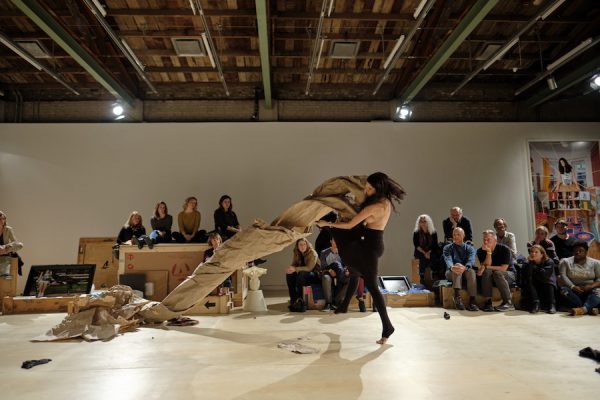
Janine Antoni in collaboration with Anna Halprin, Paper Dance, 2019 (2013). Performance view, The Contemporary Austin – Jones Center. Courtesy the artist and Luhring Augustine, New York. Image courtesy The Contemporary Austin. Photograph © Giulio Sciorio.
CC: The female body has been a dominant theme in your work. Much of your work has featured cast portions of your body, serving as a surrogate. In the works where your body is present, it is usually clothed. I read that in one of your first interactions with Halprin on the deck of her California studio, she gave you a roll of brown paper and suggested that you might consider taking off your clothes.
Tell us about your ultimate decision to perform nude in front of audiences. I would think that it takes a tremendous amount of confidence or courage to put oneself in such a vulnerable position.
JA: I am curious that you say it takes confidence to be vulnerable, when oftentimes vulnerability is seen as weakness. I believe that to show my vulnerability is a feminist offering.
Even though my physical body is exposed, it is a mistake to think Paper Dance is about me. My body is my tool, but I am not my body. I know this from being sick.
I am so deeply honored that Anna gifted me the paper from Parades and Changes. I understood that nudity was an important part of the work from its inception and was very controversial in its day. To accept the paper is to accept the nudity. It wouldn’t make sense any other way.
I have come to understand the nudity as a form of honesty. It is a stripping away of the facades that we hide behind. The real goal for me is to access the unconscious material and the emotions that are just beneath the surface. Exposing my body is nothing compared to the psychic exposure I am seeking. I want to access an authentic self that can be related to by those who witness it. Something that they know and recognize because they have a body that is fragile and scarred by time. A body that holds its history on its surface and in its bones. A body that is magical, impulsive, and expressive. A body that is beautiful because of its imperfections. Anna gave me this work as I was going into menopause. This was a personal gift. If Anna could dance nude in her eighties, then how could I let my vanity get in the way? I do happen to live in a 55-year-old woman’s body that has had cancer and a baby — a body that can express things because of all it has been through, and a body that still has a lot of life in it.
But you are right, I have been working with the female body for many years and have chosen not to be nude for art-historical reasons. It’s hard to be nude without addressing a lineage that has objectified women’s bodies. Anna’s use of nudity comes from a different place, and yet still I felt the need to bring all that I know from my own work and my art-historical lineage.
To quote Carolee Schneemann, “In some sense I made a gift of my body to other women; giving our bodies back to ourselves.” In Paper Dance I try to address the breadth of everything I have explored in my work. The body as wise, beautiful, visceral, energetic, tired, constrained by society, a spiritual vessel, an object on view, and one that looks back.
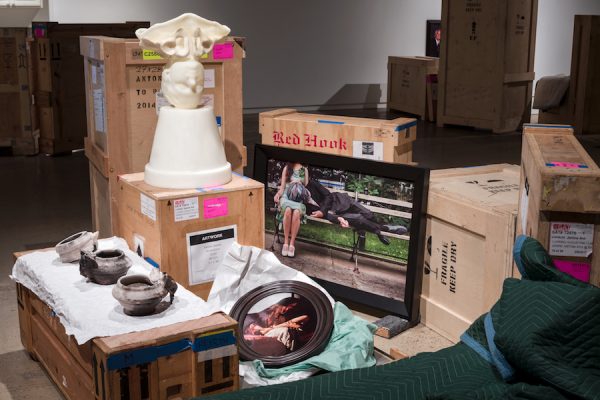
Installation view (Motherhood), Janine Antoni and Anna Halprin: Paper Dance, The Contemporary Austin. Courtesy the artist and Luhring Augustine, New York. Image courtesy The Contemporary Austin. Photograph by Colin Doyle.
CC: Your retrospective on view at The Contemporary Austin evolves over a period of almost two months, with a rotation of your works every two and half weeks, divided into three themes: motherhood, identity, and absence. Viewers can experience your work in multiple configurations — not only as the works change, but to witness your physical dynamic with the objects during the performances. This also demystifies what goes on “behind the scenes” in preparing an exhibition by making what is normally unseen visible.
JA: There are 38 works inside crates, all made over the course of the last 30 years. It’s normal in a retrospective to create thematic arrangements, so that was one “traditional” route we took, but we’re playing with this idea by rearranging the work, pulling out the themes over the span of the entire show, rather than all at once. The three themes we chose were motherhood, identity, and absence.
Each time I perform, I open two or three works until around 15 works are uncrated. After five performances we rearrange all the crates and works to create an installation that reflects the themes. The crates become almost architectural, they guide the viewers physically, enabling encounters with the artwork in unusual ways, pushing the [viewers’] physical engagement of their bodies with — and their perception of — the work. I’m channeling Anna’s late husband Lawrence Halprin here, too, and their collaborative exploration of how the body moves through space.
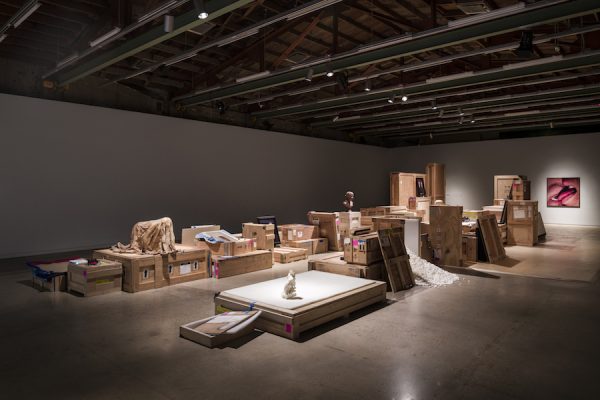
Installation view (Identity), Janine Antoni and Anna Halprin: Paper Dance, The Contemporary Austin. Courtesy the artist and Luhring Augustine, New York. Image courtesy The Contemporary Austin. Photograph by Colin Doyle.
In the exhibition on motherhood we used the crates to make small nests which put the visitors into extremely intimate and private encounters with the works. For the exhibition on identity we created two walls of crates that form a hallway, allowing the artworks to be in conversation across the passageway. In many cases we chose works that shared similar themes and yet were made at different times in my career. This speaks about the unfolding of one’s work over time, and how themes are revisited years later from a different perspective. For the absence installation we’re forming a mountain of crated artworks, using the dance floor as a pedestal, with all of the empty crates piled up in the corner. In each of these installations we’re also projecting a film excerpt of Parades and Changes within the gallery, so the connection to Anna and that history is maintained.
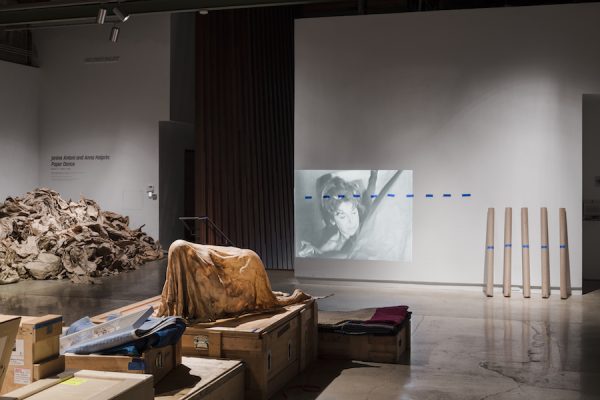
Installation view (Identity), Janine Antoni and Anna Halprin: Paper Dance, The Contemporary Austin. Courtesy the artist and Luhring Augustine, New York. Image courtesy The Contemporary Austin. Photograph by Colin Doyle.
When Anna offered me the paper to improvise with I immediately started to draw on my past work. This was completely unconscious. I think it is fascinating that I had somehow incorporated all those works and their lessons into my body and now they were all coming back to me. It was this impulse that made me decide to gather my work together and have it serve as seating for the dance.
The uncrating of the work creates a constantly changing, living environment for me to respond to. It also allows for an intimate relationship between me, the work, and the audience. I have to say there is also a power in the unseen (for example, what is inside the closed crates). The tension of what is shown and what is concealed has always been a big part of my meaning making and my way of leaving space for the viewer’s imagination. As soon as the crates became material for sculpture, their function had to be revealed. The installation then started to evolve, and I realized that the crates could be used to create a certain physical relationship to the work.
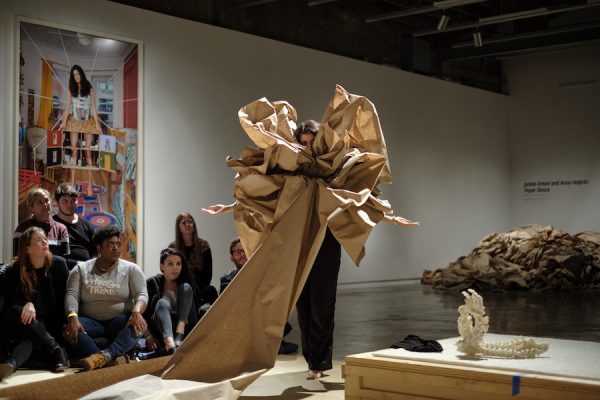
Janine Antoni in collaboration with Anna Halprin, Paper Dance, 2019 (2013). Performance view, The Contemporary Austin. Courtesy the artist and Luhring Augustine, New York. Image courtesy The Contemporary Austin. Photograph © Giulio Sciorio.
Paper Dance in general is about covering and uncovering, whether it be the crates or the paper and my body. Sometimes I like to say I am infolding and unfolding. I feel it so palpably when I am performing. I look to my material: the paper, the audience, and the work. Then I turn in to ask my body to respond. I go deep inside and listen to a story, and then I wake up and notice I am surrounded by people looking at me. I look around to see what they are thinking, and then when I find someone who is with me I dive in again, taking them with me. It mimics the creative process, or maybe just my creative process. From my somatic training I’ve learned to go inward, responding to my inner impulses, but it is my art practice that has taught me to bring those impulses into form. It is about learning to stand in the viewer’s shoes, or in this case, to sit in their seat. It is this back and forth that exemplifies the making process.

Janine Antoni in collaboration with Anna Halprin, Paper Dance, 2019 (2013). Performance view, The Contemporary Austin. Courtesy the artist and Luhring Augustine, New York. Image courtesy The Contemporary Austin. Photograph © Giulio Sciorio.
Anna’s Parades and Changes was first done in 1965 when I was one year old. I asked myself: if Anna could continue to have her dance evolve and change over so many years, how could I treat my art with the same malleability? It has been exciting to approach my work this way. And as you can imagine, it challenges all of our assumptions about how artwork should be handled and shown. It is impressive that The Contemporary Austin is capable of meeting that challenge. In the art world we want to freeze work in time and protect it so much we run the risk of killing it. But showing the work this way allows me to make a retrospective that looks back and forward at the same time. It is a way to keep my art alive. It allows me and hopefully others to look at my objects through a new lens.
CC: I’m interested in the crates as a sculptural strategy. The curatorial essay mentions that they are a framing device for the viewers. I think of them as vessels — a protective repository for history and memory, as well as containers that reveal your life’s work.
JA: Vessels of memories is a beautiful way to think about the crates. “Behind-the-scenes” is the museum’s language: for me I am just doing what I always do. I am emphasizing process and history and what it takes for those objects to exist in the world. If the audience comes to see us install, they will witness how we make decisions and how meaning is made through the relationships that are created. As you can imagine, this show took a tremendous amount of planning but we have remained very flexible and open to opportunities as things arrive, staying true to the spirit of improvisation. It’s also important for viewers to see how many minds and talents come together to make something like this happen.
CC: Will you share a funny or strange story about the preparation or making of the exhibition?
JA: When I was opening the crates at the beginning of a performance I noticed this young boy in the audience. He was playing with a rubber band. I was riveted and almost forgot I was performing. He had a huge smile of his face as he explored everything that the rubber band could do. What its qualities allowed for — its stretch and its loop for example. He used his body and the edge of my crate to explore. It was a reminder for me to treat the paper in the same way. To remember the very first time that Anna gave the paper to me. I want to stay in that first state of wonder and surprise.
Anna used to say, “Janine is so innocent.” I think it was because I was not a self-conscious mover — rather, I am a sculptor and so I let the paper move me. I remain in awe of how simple brown paper can be so provocative. How it can make so many phenomenal forms. How it tells us stories. After all these years I have come to know it intimately. For me it is alive. It reveals things to me about myself that I had no idea were there. I wonder if the audience is seeing things as well. It is my hope they are also making meanings that are important for them.
‘Janine Antoni and Anna Halprin: Paper Dance’ at The Contemporary Austin, January 23-March 17, 2019
This interview has been edited lightly for length and clarity.


